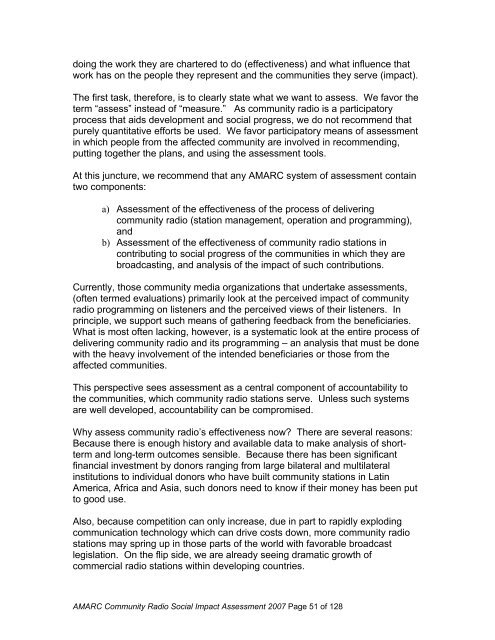Removing Barriers, Increasing Effectiveness - amarc
Removing Barriers, Increasing Effectiveness - amarc
Removing Barriers, Increasing Effectiveness - amarc
You also want an ePaper? Increase the reach of your titles
YUMPU automatically turns print PDFs into web optimized ePapers that Google loves.
doing the work they are chartered to do (effectiveness) and what influence thatwork has on the people they represent and the communities they serve (impact).The first task, therefore, is to clearly state what we want to assess. We favor theterm “assess” instead of “measure.” As community radio is a participatoryprocess that aids development and social progress, we do not recommend thatpurely quantitative efforts be used. We favor participatory means of assessmentin which people from the affected community are involved in recommending,putting together the plans, and using the assessment tools.At this juncture, we recommend that any AMARC system of assessment containtwo components:a) Assessment of the effectiveness of the process of deliveringcommunity radio (station management, operation and programming),andb) Assessment of the effectiveness of community radio stations incontributing to social progress of the communities in which they arebroadcasting, and analysis of the impact of such contributions.Currently, those community media organizations that undertake assessments,(often termed evaluations) primarily look at the perceived impact of communityradio programming on listeners and the perceived views of their listeners. Inprinciple, we support such means of gathering feedback from the beneficiaries.What is most often lacking, however, is a systematic look at the entire process ofdelivering community radio and its programming – an analysis that must be donewith the heavy involvement of the intended beneficiaries or those from theaffected communities.This perspective sees assessment as a central component of accountability tothe communities, which community radio stations serve. Unless such systemsare well developed, accountability can be compromised.Why assess community radio’s effectiveness now? There are several reasons:Because there is enough history and available data to make analysis of shorttermand long-term outcomes sensible. Because there has been significantfinancial investment by donors ranging from large bilateral and multilateralinstitutions to individual donors who have built community stations in LatinAmerica, Africa and Asia, such donors need to know if their money has been putto good use.Also, because competition can only increase, due in part to rapidly explodingcommunication technology which can drive costs down, more community radiostations may spring up in those parts of the world with favorable broadcastlegislation. On the flip side, we are already seeing dramatic growth ofcommercial radio stations within developing countries.AMARC Community Radio Social Impact Assessment 2007 Page 51 of 128
















